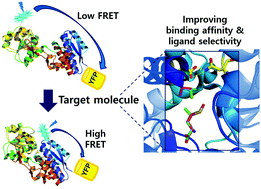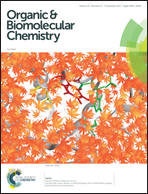Engineering a periplasmic binding protein for amino acid sensors with improved binding properties†
Abstract
Periplasmic binding proteins (PBPs) are members of a widely distributed protein superfamily found in bacteria and archaea, and are involved in the cellular uptake of solutes. In this report, a leucine-binding PBP was engineered to detect L-Leu based on a fluorescence resonance energy transfer (FRET) change upon ligand binding. A fluorescent unnatural amino acid, L-(7-hydroxycoumarin-4-yl)ethylglycine (CouA), was genetically incorporated into the protein as a FRET donor, and a yellow fluorescent protein (YFP) was fused with its N-terminus as a FRET acceptor. When CouA was incorporated into position 178, the sensor protein showed a 2.5-fold increase in the FRET ratio. Protein engineering significantly improved its substrate specificity, showing minimal changes in the FRET ratio with the other 19 natural amino acids and D-Leu. Further modification increased the sensitivity of the sensor protein (14-fold) towards L-Leu, and it recognized L-Met as well with moderate binding affinity. Selected mutant sensors were used to measure concentrations of L-Leu in a biological sample (fetal bovine serum) and to determine the optical purity of Leu and Met. This FRET-based sensor design strategy allowed us to easily manipulate the natural receptor to improve its binding affinity and specificity and to recognize other natural molecules, which are not recognized by the wild-type receptor. The design strategy can be applied to other natural receptors, enabling engineering receptors that sense biochemically interesting molecules.



 Please wait while we load your content...
Please wait while we load your content...